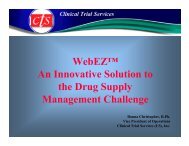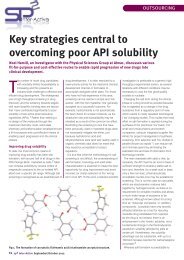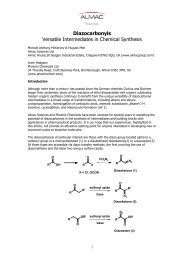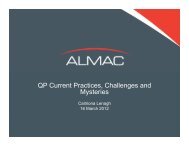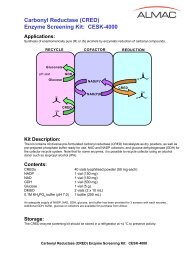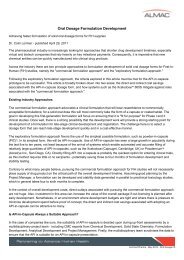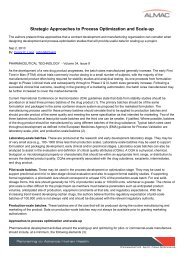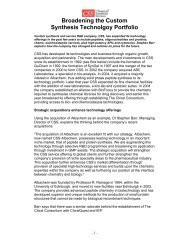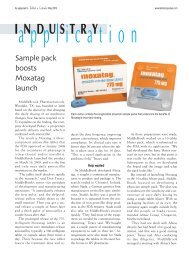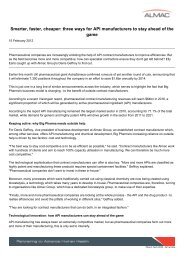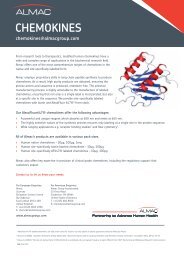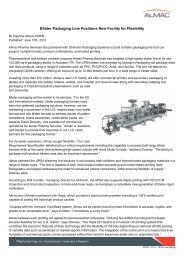CARBON-14 LABELLED API MANUFACTURING - Almac
CARBON-14 LABELLED API MANUFACTURING - Almac
CARBON-14 LABELLED API MANUFACTURING - Almac
Create successful ePaper yourself
Turn your PDF publications into a flip-book with our unique Google optimized e-Paper software.
<strong>CARBON</strong>-<strong>14</strong> <strong>LABELLED</strong> <strong>API</strong> <strong>MANUFACTURING</strong><br />
A leading CMO meeting your radiolabelling needs throughout drug development<br />
By Dr Sean L Kitson and Dr David Speed<br />
Carbon-<strong>14</strong> labelled <strong>API</strong> and IMP requirements for Phase 0/I to Phase III mass balance, and micro-dosing clinical trials can<br />
be met by contract manufacturing in compliance with MHRA and FDA Phase I cGMP guidelines. The short supply and<br />
escalating price of carbon-<strong>14</strong> labelled building blocks has emphasised the demand for robust synthetic methodologies to<br />
incorporate the carbon-<strong>14</strong> label efficiently into the <strong>API</strong>, and outsourcing to a CMO specialising in handling these<br />
challenges is a cost effective approach. Further advantages accrue to clients by incorporation of these services within an<br />
overall drug development package, from discovery through to marketing.<br />
Introduction<br />
The development of new drugs is a challenging compromise between time/cost projections and safety/efficacy profiles.<br />
Every day lost in the development of a successful drug leads to a direct loss in revenue for the pharmaceutical or<br />
biotechnology company. Every additional day worked on an unsuccessful drug sees unfulfilled investment 1 . One key<br />
element is development of an understanding of how the drug behaves in the human body, how it is absorbed, distributed<br />
and ultimately excreted 2 . Therefore a major challenge in the evaluation of an investigational drug is the early<br />
determination of its toxicological profile. Robustly designed A(D)ME (Absorption, (Distribution), Metabolism and<br />
Excretion) studies executed at an early stage in clinical development that yield useful information on the metabolism of<br />
test compounds can help avoid costly future clinical trials 3 .<br />
ADME studies require use of a radiolabelled version of the investigational drug manufactured to a quality suitable for its<br />
intended use: to generate preclinical data evaluating the metabolic profile in animals, or early clinical data in a<br />
microdosing study using human volunteers Phase 0/I 4 . If the data obtained from the study meets the drug’s<br />
expectations it can then proceed to the Investigational New Drug (IND) approval process in the USA 5 , or submission of a<br />
national Clinical Trial Authorization (CTA) in the EU 6 .<br />
In this article Drs Sean L Kitson and David Speed from <strong>Almac</strong>’s radiolabelling group consider how contract manufacturing<br />
organizations (CMOs) respond to these opportunities and challenges. Among the aspects considered are the radioactive<br />
element, the challenges of radiochemistry, the regulatory environments and critical success factors for a CMO offering<br />
these services.<br />
Carbon-<strong>14</strong> – the radioactive element of choice<br />
The rationale for selection of carbon-<strong>14</strong> in radiolabelling of drug substances lies in the ability to successfully substitute a<br />
particular carbon-12 atom in a molecule for carbon-<strong>14</strong> to produce a chemically identical analogue. The introduction of<br />
this radiolabel in the carbon framework allows the fate of the drug to be traced in a biological system. This radiotracer<br />
approach stems from the work of Melvin Calvin when he used carbon-<strong>14</strong> to determine how plants utilize carbon dioxide in<br />
the process of photosynthesis 7 .<br />
One of the primary reasons for choosing carbon-<strong>14</strong> over other common radioisotopes such as tritium is that the exact<br />
position of the label can be selected based upon the synthetic route employed for labelling. Carbon occurs in the<br />
skeleton of nearly all drug molecules, and therefore allows choice of the radiolabelling site in a position more likely to be<br />
metabolically stable 8 .<br />
Additionally carbon-<strong>14</strong> labelled compounds generally exhibit greater radiochemical stability than their tritium labelled<br />
counterparts, owing to the higher specific activity of tritium labelled material, which increases the risk of significant autoradiolysis<br />
during storage or use of the radiolabelled compound 9 . Carbon-<strong>14</strong> is also detectable at very low levels using<br />
scintillation counting, which makes it an ideal choice for in vivo studies where doses close to the pharmacological<br />
threshold are frequently used 10 .<br />
Radioactive carbon-<strong>14</strong> was discovered by Martin Kamen from the bombardment of carbon-13 with deuterons on 27 th<br />
February 1940 11 . This discovery led to the first reactor-produced radioisotope for clinical use, produced at Oak Ridge<br />
National Laboratory (ORNL) in 1946. Currently, carbon-<strong>14</strong> is produced in a nuclear reactor by the continuous<br />
bombardment of an aluminum nitride target with a flux of neutrons (12 x 10 <strong>14</strong> n/cm 2 /s). The transformation takes 2 years<br />
to ultimately provide (after processing) carbon-<strong>14</strong> labelled barium carbonate at a specific activity 50-60 mCi/mmol 12 .<br />
Drug Discovery World 2013
Measuring Radioactivity 13<br />
1 Ci (Curie) = number of disintegrations per second from 1 g of radium-226<br />
1 Bq (Bequerel) = number of disintegrations per second (SI unit)<br />
Conversion: 1 mCi = 37 MBq<br />
Specific Activity = the amount of radioactivity for a mole of compound<br />
Supply of barium [ <strong>14</strong> C]-carbonate was dominated by two main suppliers until 2009, when production at the Canadian<br />
National Research Universal reactor, located in Chalk River, Ontario was halted <strong>14</strong> . Currently, the only nuclear reactor to<br />
commercially supply barium [ <strong>14</strong> C]-carbonate is the Mayak facility in the Ural area of Russia 15 . Barium [ <strong>14</strong> C]-carbonate, the<br />
primary carbon-<strong>14</strong> labelling source, is converted to [ <strong>14</strong> C]-carbon dioxide which can be reacted to generate a variety of<br />
aromatic and aliphatic carbon-<strong>14</strong> building blocks (Figure 1) 16 .<br />
Carbon-<strong>14</strong> is a low energy beta emitter (maximum 156 keV) with a half-life of 5730±40 years, compared to that of<br />
tritium at 12.3 years. This means that there is no need for correction for radioactive decay during the course of a drug<br />
development programme.<br />
As it requires limited shielding (maximum beta range in air: 24 cm, water/tissue: 0.28 mm and plexiglas/lucite/plastic:<br />
0.25 mm) it is relatively safe to handle, and this helps to confirms it as the radiolabel of choice for quantitative mass<br />
balance and tissue distribution studies 17 .<br />
Ba <strong>14</strong> CO 3<br />
<strong>14</strong> CH 3 I R <strong>14</strong> CO 2 H<br />
<strong>14</strong> CO 2<br />
<strong>14</strong> C <strong>14</strong> C<br />
U- <strong>14</strong> C<br />
K <strong>14</strong> CN<br />
<strong>14</strong> C-DMF<br />
Challenges of Radiochemistry<br />
Figure 1. Building blocks from Barium [ <strong>14</strong> C]-carbonate<br />
Design of a radiolabelling synthesis depends on a number of interdependent factors, which ultimately determine the<br />
labelling position within the molecule. These factors must be carefully considered along with any prior knowledge of the<br />
molecule to ensure that a metabolically stable labelling position is achieved:<br />
Drug Discovery World 2013
• Identification of a synthetic pathway: a limited range of carbon-<strong>14</strong> starting materials is available, and existing<br />
synthetic procedures are often not appropriate or efficient with expensive labelled reagents.<br />
• Selection of appropriate starting materials: beginning a synthesis from barium [ <strong>14</strong> C]-carbonate may help to<br />
reduce material costs, but can lead to increased labour cost due to a longer synthesis. Use of a more advanced<br />
starting material is often cost effective since smaller amounts and fewer steps to completion are required.<br />
• Other factors such as the amount of material and the specific activity required may also influence the synthetic<br />
design.<br />
The exceedingly slow radioactive decay of carbon-<strong>14</strong> to nitrogen-<strong>14</strong> leads to negligible decomposition of material on a<br />
human timescale, however the ionising radiation generated may lead to secondary chemical reactions resulting in very<br />
significant radiochemical decomposition 18 . This effect cannot be predicted with certainty, and may result in changes of<br />
less than 1% over several years, up to several % in a week. Common precautions to minimise the effect include diluting<br />
the material with unlabelled active pharmaceutical ingredient (<strong>API</strong>) or a solvent, and storing the labelled <strong>API</strong> at cryogenic<br />
temperatures (typically
The various regulations are complicated, and continuously being updated, so in addition to supplying fit-for-purpose<br />
carbon-<strong>14</strong> materials, made using the most cost effective synthetic strategies, a CMO must be able to support and guide<br />
study sponsors through the entire process, up to and including Qualified Person (QP) release of IMP, to help ensure a<br />
successful outcome for their project. This is particularly important for smaller biotech or virtual companies who may not<br />
have previous experience with radiolabelling studies.<br />
CMO Radiolabelling Facility<br />
A radiolabelling facility (Figure 2) must be designed with quality and regulatory requirements in mind, and must<br />
additionally be able to address the full range of materials encountered in drug development pipelines, which may include<br />
heterocycles, aromatics, chiral compounds, peptides and proteins, steroids, volatile compounds, sugars, PEGylated<br />
materials, cytotoxic and highly potent compounds 16 , 26 . By its nature, radiolabelling imposes constraints, and presents<br />
challenges beyond those found in medicinal synthesis laboratories. The synthetic route can be quite different to that<br />
employed for unlabelled <strong>API</strong>, and the carbon-<strong>14</strong> labelled <strong>API</strong> may possess dramatically different stability and impurity<br />
profiles. Radioactive materials must be fully tracked from their arrival on-site, until their eventual dispatch as either<br />
products or waste, which imposes further conditions on the manner in which chemistry may be carried out.<br />
Figure 2. GMP Radiolabelling Facility<br />
All handling of radiolabelled materials is carried out within fume hoods, both to protect personnel from exposure, and<br />
also to protect the quality of the material itself. Equipment for manipulation of volatiles and for purification and isolation<br />
of final materials (eg semi-preparative HPLC, freezedrying and milling apparatus) is required, as well as the analytical<br />
capacity to determine the quality of labelled compounds. Dedicated GMP suites contain an extensive range of validated<br />
analytical equipment, such as scintillation counters, high performance liquid chromatography (HPLC) systems (including<br />
radioactivity detectors as well as traditional detection methods), dissolution and disintegration apparatus, titrators and<br />
meters. Larger items of apparatus such as nuclear magnetic resonance (NMR) spectrometers, high resolution mass<br />
spectrometers and X-ray diffractometers may not be available within dedicated radiolabelling facilities, and in this<br />
instance a CMO must have access to these services elsewhere on-site.<br />
Determination of stability of radiolabelled materials is frequently of pivotal importance to the success of a radiolabelling<br />
study, and the capacity to carry out GMP stability studies to ICH standards (including the commonly used
Regular training ensures that developments and improvements are applied and recorded consistently throughout the<br />
CMO organisation. Process development is typically carried out using unlabelled materials (cold trials) and/or highly<br />
diluted radioactive materials (warm trials) to optimise the parameters required for the labelled <strong>API</strong> synthesis. Vital<br />
information regarding reaction step yields, impurities and purification of the intermediates and <strong>API</strong> is obtained, and<br />
reagents to be used in the labelled cGMP synthesis are tested for fitness - especially important when using expensive<br />
carbon-<strong>14</strong> labelled starting materials. Other benefits of carrying out cold or warm trials is to investigate the effects of<br />
scale (typically hundreds or thousands of times lower than plant procedures) and to validate analytical methods to be<br />
used with the final manufacture.<br />
A hot trial, using undiluted radiolabelled material is often carried out as a final verification of the process parameters,<br />
since differences are occasionally observed between labelled and unlabelled materials, particularly with regard to stability.<br />
Indeed, an important aim of the hot trial is often to provide materials for determination of stability, to ensure that under<br />
the study conditions the <strong>API</strong> will stay within specification.<br />
The point at which cGMP controls are required in the synthesis must be agreed with the study sponsor, usually a covalent<br />
bond forming step which results in formation of the major backbone of the molecule. Obviously fewer cGMP steps<br />
required leads to cost savings, and in cases where a significant dilution with unlabelled <strong>API</strong> is being carried out (≥1:100<br />
typically), it may even be possible to use nonGMP radiolabelled <strong>API</strong> blended with GMP-grade unlabelled <strong>API</strong> (subject to<br />
an acceptable history of the nonGMP material, especially regarding potential exposure to transmissible spongiform<br />
encephalopathies (TSE).<br />
Detailed manufacturing directions are prepared, including details of reagents, reaction conditions, in process checks,<br />
purity limits and testing, etc. After Quality Assurance (QA) approval and issue of these directions, verification of<br />
equipment and facility cleaning, and once the required reagents and materials have been certified and released by the<br />
Quality Control (QC) and QA departments the cGMP manufacture may commence.<br />
Full records of all equipment used in the manufacture are maintained, and an electronic stock control system tracks the<br />
movements and use of reagents as well as the intermediates and <strong>API</strong> as they are formed. In process checks, and<br />
analyses of intermediates and <strong>API</strong> are carried out against pre-determined specifications, which are developed to cover<br />
the key quality determining parameters of the material. This typically includes confirmation of identity by methods such<br />
as mass spectrometry and NMR, as well as purity assessment (HPLC), and solvent content (GC). Solid <strong>API</strong>s may exist in<br />
more than one polymorph, with serious implications for their physical behaviour, and confirmation of polymorphic form<br />
by X-ray powder diffraction (XRPD) is frequently required, a specialised technique offered by only a few CMOs (Figure<br />
3a). Comparison of the measured XRPD spectrum to a reference material allows confirmation that the same polymorph<br />
has been obtained (Figure 3b) 27 .<br />
Drug Discovery World 2013
Unlabelled <strong>API</strong><br />
Figure 3a: XRPD Instrument<br />
Carbon-<strong>14</strong> labelled IMP<br />
Figure 3b: XRPD spectrum of the<br />
unlabelled <strong>API</strong> and <strong>14</strong> C IMP<br />
The quality system applies to all aspects of the cGMP activities and is subject to frequent audits, which verify continuous<br />
regulatory compliance at every stage from receipt of materials, through to the <strong>API</strong> manufacture and final release of <strong>API</strong>.<br />
In addition to internal audits, study sponsor audits, and radiation compliance checks, CMOs may voluntarily request<br />
compliance checks by agencies such as the Medical and Healthcare Regulations Authority (MHRA, UK) or Federal Drugs<br />
Authority (FDA, US) as a further demonstration of their quality status.<br />
Critical Success Factors - Integration<br />
A drive is on by pharmaceutical and biotechnology organizations to outsource more of their operations to service<br />
providers, especially for specialised services such as carbon-<strong>14</strong> labelled <strong>API</strong> manufacture. Radiolabelling in a GMP setting<br />
can be costly (although it is a small fraction of the overall cost of launching a drug to market) but the information gained<br />
during the synthesis is necessary to support the drug in the later stages of clinical development, and in contributing data<br />
towards the drug’s safety profile.<br />
A CMO must retain highly skilled personnel encompassing a range of expertise in the areas of synthetic organic<br />
chemistry, isotope labelling, solid state chemistry, analysis, product formulations and quality assurance. A changing<br />
Drug Discovery World 2013
marketplace and demands on materials and costs enforce a discipline of continuous improvement on CMOs in order to<br />
remain competitive, whilst maintaining high quality standards throughout the process. This is all governed by exacting<br />
regulatory requirements, and critical timelines to deliver high quality products for use in clinical trials.<br />
A number of CMOs offer radiolabelling services, a more limited number cater for cGMP radiolabelling 28-29 . Practical<br />
capabilities in radiolabelling and an established track record in regulatory compliance are strategically vital for these<br />
CMOs. Through integration of services some CMOs are able to offer even greater benefits: by providing in-house<br />
biocatalysis, physical sciences and peptide synthesis departments, formulation specialists and clinical trial support a<br />
compelling service offering to customers involved in drug development pipelines is created.<br />
An integrated offering allows the CMO to better serve customers by taking advantage of the synergies that exist between<br />
the supply of <strong>API</strong>, their associated metabolites and labelled analogues. Intellectual property protection is also enhanced<br />
by performing all key stages of the drug development process under one roof, from pre- & formulation development,<br />
stability studies, method development, pre-clinical and Phase I clinical trial materials, late-stage clinical trial materials, to<br />
scale-up and registration batches, and commercial production.<br />
Conclusion<br />
Pharmaceutical Companies need a reliable supply of isotopically labelled <strong>API</strong>s. The isotope of choice is carbon-<strong>14</strong> to<br />
produce <strong>API</strong> for Phase 0 to Phase III, ADME, mass balance, and micro-dosing studies. A present challenge is the<br />
escalating price of carbon-<strong>14</strong> labelled building blocks generated from carbon-<strong>14</strong> labelled barium carbonate, which is at<br />
present is in short supply. Consequently, there is even more pressure on the radiochemist to execute robust synthetic<br />
methodologies to incorporate the carbon-<strong>14</strong> label efficiently into the <strong>API</strong>.<br />
For human studies, this necessitates procedures to perform synthesis and repurifications under cGMP conditions, in<br />
compliance with ICH Q7A Section 19 guidelines (single batches for investigational drugs) and/or MHRA guidelines for the<br />
preparation of carbon-<strong>14</strong> labelled <strong>API</strong>s for clinical trials. These carbon-<strong>14</strong> labelled compounds provide vital information<br />
for chemistry, manufacturing and controls (CMC) towards investigational medicinal product dossier (IMPD) submission.<br />
Authors<br />
Dr Sean L Kitson is an Investigator at <strong>Almac</strong> and has more than 10 years’ experience in the synthesis of carbon-<strong>14</strong><br />
radiolabelled compounds. He is also the Editor-in-Chief of Current Radiopharmaceuticals and a Scientific Committee<br />
Member of the International Isotope Society (UK Group). He is a recipient of the 2006 Wiley Journal of Labelled<br />
Compounds and Radiopharmaceuticals Award for radiochemistry.<br />
Dr David Speed is a Technical Leader of Radiochemistry at <strong>Almac</strong> and has more than 5 years experience in the GMP<br />
synthesis and analysis of carbon-<strong>14</strong> radiolabelled compounds. He also provides IMP manufacturing skills to the group<br />
and is one of the on-site Radiation Protection Supervisors.<br />
References:<br />
1 Paul, SM, Mytelka, DS, Dunwiddie, CT, Persinger, CC, Munos, BH, Lindborg, SR and Schacht, AL. How to improve<br />
R&D productivity: the pharmaceutical industry's grand challenge. Nat Rev Drug Discov, 2010. 9: p.203-2<strong>14</strong>.<br />
2 Lin, JH and Lu, AYH. Role of Pharmacokinetics and Metabolism in Drug Discovery and Development. Pharmacol<br />
Rev, 1997. 49: p.403-449.<br />
3 Marathe, PH, Shyu, WC and Humphreys, WG. The Use of Radiolabelled Compounds for ADME Studies in Discovery<br />
and Exploratory Development. Curr Pharm Design, 2004. 10: p.2991-3008.<br />
4 Penner, N, Xu, L and Prakash C. Radiolabeled Absorption, Distribution, Metabolism, and Execretion Studies in Drug<br />
Development: Why, When, and How? Chem Res Toxicol, 2012. 25: p.513-531.<br />
5 Development & Approval Process (Drugs). http://www.fda.gov/drugs/developmentapprovalprocess/<br />
6 Licensing of medicines.<br />
Drug Discovery World 2013
http://www.mhra.gov.uk/Howweregulate/Medicines/Licensingofmedicines/<br />
7 Calvin, M. The Photosynthetic Cycle. Bull Soc Chim Biol, 1956. 38(11): p.1233-1244.<br />
8 Penner, N, Klunk, LJ and Prakash C. Human Radiolabelled Mass Balance Studies: Objectives, Utilities and<br />
Limitations. Biopharm Drug Dispos, 2009. 30: p.185-209.<br />
9 Bayly, RJ and Evans, EA. Stability and storage of compounds labelled with radioisotopes. J Labelled Compd<br />
Radiopharm, 1966. 2: p.1–34.<br />
10 Alimonti, G, Angloher, G, Arpesella, C, Balata, M and Bellini, G et al. Measurement of the <strong>14</strong> C abundance in a lowbackground<br />
liquid scintillator. Physics Letters B, 1998. 422(1-4): p.349-358.<br />
11 Kamen, MD. Early History of Carbon-<strong>14</strong>: Discovery of this supremely important tracer was expected in the physical<br />
sense but not in the chemical sense. Science, 1963. <strong>14</strong>0(3567): p.584-590.<br />
12 Davis, W. Carbon-<strong>14</strong> production in nuclear reactors. ORNL/NUREG/TM-12. U.S. Nuclear Regulatory Commission.<br />
1977.<br />
13 Radioactivity. Encyclopædia Britannica. Encyclopædia Britannica Online. Encyclopædia Britannica Inc., 2012.<br />
http://www.britannica.com/EBchecked/topic/489089/radioactivity.<br />
<strong>14</strong> Canadian Nuclear Safety Commission.<br />
http://nuclearsafety.gc.ca/eng/mycommunity/facilities/chalkriver/<br />
15 Mayak. www.po-mayak.ru<br />
16 McCarthy, K. Recent Advances in the Design and Synthesis of Carbon-<strong>14</strong> Labelled Pharmaceuticals from Small<br />
Molecule Precursors. Curr Pharm Design, 2000. 6(10): p.1057-1083.<br />
17 Nuclide Safety Data Sheet Carbon-<strong>14</strong>. http://safety.uncc.edu/sites/safety.uncc.edu/files/Carbon%20<strong>14</strong>.pdf<br />
18 In Guide to the Self-Decomposition of Radiochemicals, Amersham International Plc, Buckinghamshire, 1992.<br />
19 Fredenhagen, A. Radiochemical stability of <strong>14</strong> C-compounds on storage: benefits of thioethers. J Labelled Compd<br />
Radiopharm 2003. 46: p.211–220.<br />
20 Lappin, G, Wagner, CC, Langer, O and Merbel, van de N. New ultrasensitive detection technologies and techniques<br />
for use in microdosing studies. Bioanaysis, 2009. 1(2), p.357-366.<br />
21 Turteltaub, KW and Vogel, JS. Bioanalytical Applications of Accelerator Mass Spectrometry for Pharmaceutical<br />
Research. Curr Pharm Design, 2000. 6: p.991-1007.<br />
22 Lappin, G and Garner, RC. Current perspectives of <strong>14</strong> C-isotope measurement in biomedical accelerator mass<br />
spectrometry. Anal Bioanal Chem, 2004. 378: p.356-364.<br />
23 Vuong, Le T, Ruckle, JL, Blood, AB, Reid, MJ, Wasnich, RD, Synal, H-A, Dueker, SR. Use of Accelerator Mass<br />
Spectrometry to Measure the Pharmacokinetics and Peripheral Blood Mononuclear Cell Concentrations of<br />
Zidovudine. J Pharm Sci, 2007, p.1-11.<br />
24 The Ionising Radiation Regulations 1999. http://www.legislation.gov.uk/uksi/1999/3232/contents/made.<br />
Drug Discovery World 2013
25 ICH Harmonised Tripartite Guideline CPMP/ICH/286/95: Guidance on Nonclinical Safety Studies for the Conduct of<br />
Human Clinical Trials and Marketing Authorization for Pharmaceuticals M3(R2), June 2009. FDA: Published in the<br />
Federal Register, Vol. 75, No. 13, Docket No. FDA-2008-D-0470, p3471, January 2010.<br />
26 Kitson, SL. Keeping Tags on Biomolecules. Manufacturing Chemist, 2012. p.36-37.<br />
27 Kitson, SL. Accelerated Radiochemistry. PMPS Manufacturing 2010, p.68-70, 2010.<br />
28 Roberts, D. Custom Carbon-<strong>14</strong> Radiolabelling – Investing to Meet New Challenges. Drug Discovery World Winter<br />
2009/10, p.53-60.<br />
29 Roberts, D and Lockley, W. Radiosynthesis: a vital role supporting drug development? Drug Discovery World Fall<br />
2004, p.59-64.<br />
Drug Discovery World 2013




